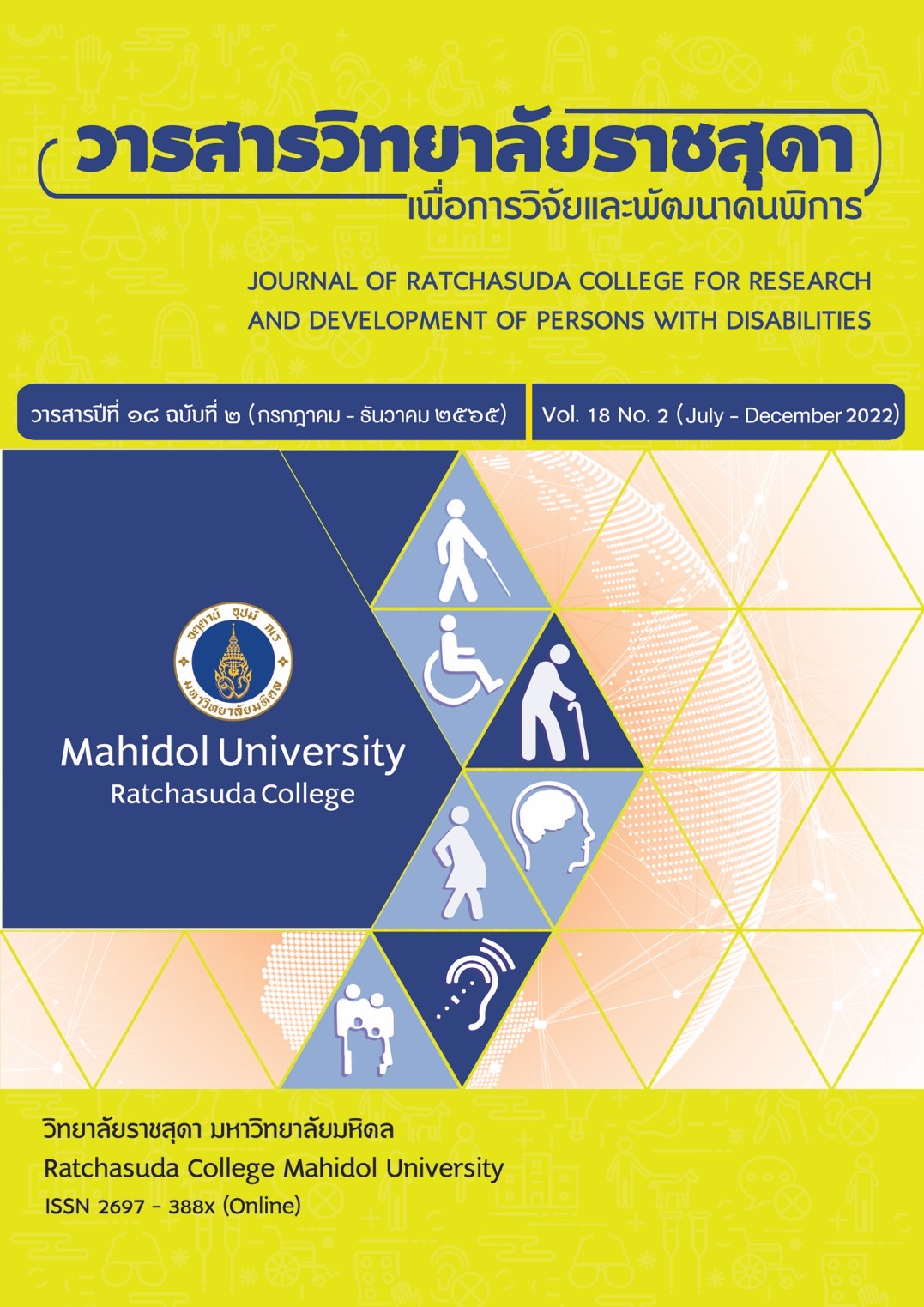Psychometric properties of the sign language version of the Thai version-Revised Olweus Bully/Victim Questionnaire - victim scale
Keywords:
Bully, Hearing Impairment Student, Questionnaire, Sign LanguageAbstract
This study aimed to develop and verify psychometric properties of the sign language version of Thai-version -Revised Olweus Bully/Victim Questionnaire, victim scale in junior high school with hearing impairment and study about the experience being bullied in this group of students. The researcher translated the Revised Olweus Bully/Victim Questionnaire (OBVQ) Thai version was translated into sign language according to Guidelines for the Process of Cross-Culture Adaptation of Self-Report Measure. Content validity was verified using Index of Item Objective Congruence (IOC) by the 3-expert committee. The committee members consist of sign-language interpreter, hearing impaired and psychological expert. The results found that IOC score was greater than 0.50 for every item of the questionnaire. A pilot study was done excellently in 5-hearing impairment students on self-report questionnaire and sign language interview. 38 junior high school students from the School for the Deaf were enrolled. Cronbach’s Alpha Coefficient and intraclass correlation coefficient of test-retest reliability was used to assess the reliability of the victim scale. Cronbach’s Alpha Coefficient was 0.871 and intraclass correlation coefficient of test-retest reliability was 0.867 (95% CI 0.54-0.95). And, this study shows that the results suggest that the sign language version of Thai-version OBVQ, victim scale has good validity and reliability. It appears 47.37 % of student with hearing impairment being bullied at rate 2-3 time a month which is higher than reported by hearing students in another study before.
Downloads
References
Arayavinyu, P. (1999). Education of children who special needs (2nd ed.). Bangkok:
Wankaen.
Beaton, D. E., Bombardier, C., Guillemin, F., & Ferraz, M. B. (2000). Guidelines for the process of cross-cultural adaptation of self-report measures. Spine, 25(24), 3186-3191.
Broekhof, E., Bos, M. G., Camodeca, M., & Rieffe, C. (2018). Longitudinal associations between bullying and emotions in deaf and hard of hearing adolescents. Journal of Deaf Studies and Deaf Education, 23(1), 17-27.
Charoenwanit, S. (2017). Cyber bullying: Impacts and preventions in adolescents. Thai Science and Technology Journal, 25(4), 639-648.
Cheng, A. W., Chou, Y. C., & Lin, F. G. (2019). Psychological distress in bullied deaf and hard of hearing adolescents. Journal of Deaf Studies and Deaf Education, 24(4), 366-377.
Dechothanawat, C. (2011). Problems of bullying and depression among students in grades 1-3 of a coeducational government school in Bangkok Noi District, Bangkok. (Dissertation). Mahidol University, Bangkok, Thailand.
Dixon, W. J., & Massy, F. J. (1983). Introduction to statistical analysis (4th ed.). Auckland: McGraw-Hill.
Ekasawin, S., & Phothisut, C. (2017). Prevalence of bullying experiences and psychiatric disorders in Thai students. Journal of Mental Health of Thailand, 25(2), 96-106.
Espelage, D. L., Jimerson, S. R., & Swearer, S. M. (2010). Handbook of bullying in schools: An international perspective. New York: Routledge.
Fumes, N., & Oliveira, M. (2013). Bullying, deaf students and physical education classes. Hacettepe Journal of Sport Sciences - Spor Bilimleri Dergisi, 24(4), 255-259.
Hadjikakou, K., & Panayiotis, P. (2012). Bullying and cyberbullying and deaf and hard of hearing children: A review of the literature. International Journal on Mental Health and Deafness, 2(1), 18-32.
Juajun, S. (2011). A study of Thai consonants variations of hard impaired children. (Master’s thesis). Silpakorn University, Nakhon Pathom, Thailand.
Lund, E., & Ross, S. (2016). Peer victimization in students who are deaf and hard of hearing: Exploring educational placement. JADARA, 50(2), 20-44.
McLaughlin, C., Byers, R., & Vaughn, R. P. (2010). Responding to bullying among children with special educational needs and/or disabilities. London: Anti-Bullying Alliance.
National Deaf Children’s Society. (2016). Bullying: Advice for parents of deaf children (2nd ed.). London: Author.
Niyomthum, S. (2001). Hearing impairment: Impacting of psychological, educational, and social. Bangkok: Wankaen.
Padden, C., & Ramsey, C. (1998). Reading ability in signing deaf children. Topics in Language Disorders, 18, 30-46.
Pinquart, M., & Pfeiffer, J. P. (2015). Bullying in students with and without hearing loss. Deafness & Education International, 17(2), 101-110.
Pruksapanachart, B. (2011). The relationship between bullying behavior and self-esteem in attention deficit/hyperactivity disorder patients. Journal of Psychiatric Association Thailand, 56(2), 93-102.
Saylor, C. F., & Leach, J. B. (2009). Perceived bullying and social support in students accessing special inclusion programming. Journal of Developmental and Physical Disabilities, 21(1), 69-80.
Sittichai, R., & Smith, P. K. (2018). Bullying and cyberbullying in Thailand: Coping strategies and relation to age, gender, religion and victim status. Journal of New Approaches in Educational Research, 7(1), 24-30.
Solberg, M. E., & Olweus, D. (2003). Prevalence estimation of school bullying with the Olweus bully/victim questionnaire. Aggressive Behavior: Official Journal of the International Society for Research on Aggression, 29(3), 239-268.
Tapanya, S. (2006). Student bullying problem survey report. Chiang Mai: Department of Psychiatry, Faculty of Medicine, Chiang Mai University.
Thompson-Ochoa, D., & Hodgdon, P. (2019). The impact of bullying and victimization among deaf students in residential schools and distressful behaviors of deaf students. International Journal of Psychology and Counselling, 11(5), 39-45.
United Nations Children’s Fund (UNICEF). (2018). An everyday lesson: #Endviolence in schools. New York: Division of Communication, Programme Division/Child Protection and Education.
Weiner, M. T., Day, S. J., & Galvan, D. (2013). Deaf and hard of hearing students’ perspectives on bullying and school climate. American annals of the Deaf, 158(3), 334-343.
Wise, J. M. (2015). Preventing and responding to bullying and cyberbullying incidents among deaf and hard-of-hearing students (Doctoral dissertation). California State University, Northridge.
Woracharoensri, S. (2016). Bullying. Encylopedia of Education, 51, 13-20.
Downloads
Published
How to Cite
Issue
Section
License
Copyright (c) 2022 JOURNAL OF RATCHASUDA COLLEGE FOR RESEARCH AND DEVELOPMENT OF PERSONS WITH DISABILITIESบทความที่ได้รับการตีพิมพ์เป็นลิขสิทธิ์ของวารสารสถาบันราชสุดาเพื่อการวิจัยและพัฒนาคนพิการ






